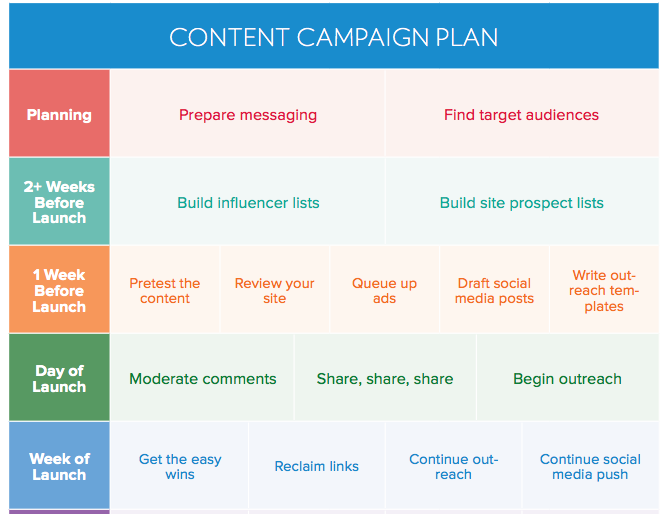This is a continuation post on “The Blogging Newbie’s Guide To Content Promotion Strategy” (Part 1), published last month to help the blogging n00bs of the world take first steps in forming a content promotion strategy.
It’s too important a component of your content marketing strategy to scrimp on. And yet, so many businesses and agencies producing content do. It’s just sad—getting a blog post all dressed up with nowhere to go.

Too often, those just starting out in content marketing period quickly get lost in terminology and don’t establish the foundational basics of content promotion prior to jumping into more advanced techniques, like influencer marketing, republishing on platforms like Medium, and guest blogging, to name a few.
Consider this analogy: Why would you expect you could break world records in the 200-meter butterfly race, when Michael Phelps has been training since childhood, piecing together his technique, strategy, and building his endurance over time? If you can’t float or hold your breath underwater as foundational pieces of your swim stroke, you can bet your dreams for swimming world domination ain’t happening. Not until you take several steps back and start from the beginning, anyway.

If you haven’t yet, visit part 1 of this post. As promised, this post will up the ante and bridge the gap between beginner and advanced promotion strategies. (Soon, you’ll be ready to take on the methods mentioned in such bomb resources as this and this.)
With each content promotion strategy tactic mentioned in the last post, I’ll raise you a more advanced technique. Soon you’ll be all-in on content promotion and reaping the rewards.

1. Have original content in your pocket.
I raise you: Seek out guest blogging opportunities for that original content.
You don’t have to post every original piece of content you’ve written (or outsourced) on your own blog. For those pieces that are some of your very best work or that you feel will be particularly helpful for a slightly pivoted audience, find another blog that’ll publish your post.
How to get started guest blogging? Start with these resources:
- 5 Simple Steps To More Successful Guest Blogging
- How Does Guest Blogging Work?
- 6 Ways Guest Blogging Can Give Your Business Blog A Boost
Warning: Do be sure, however, that you’re not duplicate posting these posts on your blog AND on another blog if they’re going to have a similar impact. I’d hate for you to get dinged for duplicate content this way. To figure out which posts you should post on your own blog vs. seek out guest blogging opportunities for, check out this edition of Moz’s Whiteboard Friday.
2. Figure out where your audience lives, researches, and learns.
I raise you: Optimize for top platforms, seek out others where you can find similar, untapped audience members.
As explored in Part 1, there are multitudes of places people go to imbibe content they trust in their industry.
Take Verrblio (formerly BlogMutt), for example. We discovered from our Google Analytics data that we got lots of conversions/blog reads via email newsletters and more eyes on our blog posts from the content curation platform Medium.
For email, we’ve optimized by taking great care in curating a monthly newsletter with the most timely, helpful content to bring value to our email subscribers. This remains valuable for people because we boil down the top posts of the month to just three or four blog posts, and a strong call-to-action to visit the blog, subscribe, or anything else we deem worthy for that month.
Additionally, set up a daily blog email notification (or however often you’re publishing content) for visitors to subscribe to, if you’ve found email as critical a content distributor as we have. You betcha when people get your blog post delivered to their inbox everyday, they’re more likely to read it and potentially share it. Free promotion!
Next on our list of platforms to continue pioneering is Medium. We’ve already got our Medium up and healthily running, but we’re looking forward to flexing some of Buffer’s recent insights to bulk up our own efforts. It’s a unique platform where great content really sings.
3. Set up your Google Analytics to track your efforts.
I raise you: Organize actions, determine goals.
What you’ll need for this is a template for considering the promotion of each individual piece of content. We’ll pull from one of the thought leaders in content promotion: Buzzstream.
Going through this process will give you good discipline and lay the framework you can adhere to with every piece of content you develop, and thereby need to promote.
 (via Buzzstream’s ‘Advanced Guide to Content Promotion‘)
(via Buzzstream’s ‘Advanced Guide to Content Promotion‘)
4. Repurpose the bejesus out of the content you have.
I raise you: Package it up differently, including who shares that content.
You’ll need to explore which format content performs best in. What started as a blog post might just get more traction as an infographic, or a series of posts. (See what I did there?) If the content exists already, there’s no telling what second lives it could have, especially if it’s high-quality.
Think outside the box: Slideshares, for example, perform well. And if you’re on a tight budget, don’t rule out seemingly expensive formats like video. You don’t have to go all-out on video to try it. If you’ve whipped up blog posts or white papers, or even done something internal like a lunch-n-learn, record a quick video on a low-budget app like Instagram or SnapChat and share it across your social channels. It’s tough to ignore how increasingly important video is becoming.
Also included in this are influencers, who can be the different “packaging” for content in and of themselves. If you’ve got a bomb piece of content that you would like shared, reach out to influencers to get the word out. BUT. You’ve got to start that relationship early, and not expect them to share just after one reach-out.
Not sure how to get started? Here’s the definitive guide to influencer marketing.
5. The greats are always experimenting.
I raise you: Determine which social post formats, times drive most engagement.
Now that you’ve been posting to your social channels for a while, try to mix it up in terms of images you post, timing of posts, voice/tone, etc. Try to suss out actionable patterns.
Get minimal interactions on Friday afternoons? Post less!
See an uptick in video watch-throughs on weekday evenings? Save videos for those times!
Find that your followers would rather see the full title of a blog post instead of your pithy commentary? Stay concise and stick to the title only!
We use Canva at Verblio to format images & overlay text like the one embedded in this post, which we’ve found increases engagement sizeably when attached to a social media update of a blog post.
6. Enjoy the journey.
I raise you: Never stop building & fostering relationships.
Every single person who interacts with your content should mean something to you.
Every. Single. One.
No matter if they have 10 followers or thousands, they took that extra step of their own volition to share or like your piece of content.
What should you do to build good blog sharing karma?
- If you quote someone in a blog post (make sure to always attribute!), call them out (either on social or email) to let them know and thank them for their wisdom.
- Retweet, share, and like other great pieces of content out there. There’s plenty of it, and the creator will always be grateful for it.
- Respond to every comment, question, or critique you get, no matter how negative. Fostering a sense of community and conversation will make you (or your brand) instantly more relatable.
- Offer guest blogging opportunities of your own for freelancers or other brands to spread the word.
- Rinse and repeat the above steps.
And, if you end up exhausting these, here are 143 more ideas (behold, the wealth of knowledge the internet boasts!) to keep your promotion ideas fresher than farmer’s market produce.
Important note: It’s easy to get caught up in trends in content marketing’s echo chamber. Pick and choose carefully which promotion tactics will get the best traction in your audience, or those that you’re genuinely curious about.
Throughout every experiment, keep your finger on the audience’s pulse and a watchful eye on your Google Analytics. Try to introduce each new tactic as its own variable and measure the effects. Like the scientific method, you want to isolate variables to determine with exactness what’s effective and what’s not.
And now, you can consider yourselves armed and properly informed in content promotion strategy.
(And finally no longer newbies. :))



